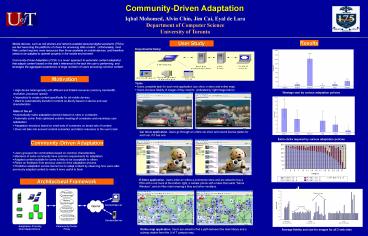Migration of Legacy systems into Object Oriented Architecture - PowerPoint PPT Presentation
1 / 1
Title:
Migration of Legacy systems into Object Oriented Architecture
Description:
Mobile devices, such as cell phones and network-enabled personal digital assistants ... cellular phone with a label that reads 'Sierra Wireless', and an Aibo robot ... – PowerPoint PPT presentation
Number of Views:42
Avg rating:3.0/5.0
Title: Migration of Legacy systems into Object Oriented Architecture
1
Results
User Study
Mobile devices, such as cell phones and
network-enabled personal digital assistants
(PDAs) are fast becoming the platforms of choice
for accessing Web content. Unfortunately, most
Web content requires more resources than those
available on mobile devices, and therefore needs
to be adapted to operate properly in the mobile
environment. Community-Driven Adaptation (CDA)
is a novel approach to automatic content
adaptation that adapts content based on the
datas relevance to the task the user is
performing, and leverages the aggregate
experiences of large numbers of users accessing
common content.
Experimental Setup
Motivation
- Tasks
- Users complete task for each web application
(car show, e-store and online map) - Users increase fidelity of images if they need
to (indicated by right image below)
- High device heterogeneity with different and
limited resources (memory, bandwidth, resolution,
processor speed) - Impractical to create content specifically for
all mobile devices - Want to automatically transform content
on-the-fly based on device and user
characteristics - State of the art
- Automatically make adaptation decision based on
rules or constrains - Automatic solver finds optimized solution
meeting all constrains and maximizes user
satisfaction - Adaptation decisions based on small sets of
constrains on broad sets of content - Does not take into account content semantics and
datas relevance to the users task
Wastage sent by various adaptation policies
Car show application. Users go through an online
car show and record license plates for each car,
if it has one.
Extra clicks required by various adaptation
policies
Community-Driven Adaptation
- Users grouped into communities based on common
characteristics - Members of same community have common
requirements for adaptation - Adapted content suitable for some is likely to
be acceptable to others - Relies on feedback from previous users to drive
adaptation process - Predictive adaptation service learns how to
adapt content by observing how users alter
previously adapted content to make it more useful
to them
E-Store application. Users enter an online
e-commerce store and are asked to buy a PDA with
a red mark at the bottom right, a cellular phone
with a label that reads "Sierra Wireless, and an
Aibo robot wearing a blue and silver necklace.
Architectural Framework
E-store Fidelity class distribution for users
Online map application. Users are asked to find a
path between the main library and a subway
station from the U of T campus map.
Average fidelity and size for images for all 3
web sites































